- Features
-
Services/ProductsServices/ProductsServices/Products

Learn more about the retail trading conditions, platforms, and products available for trading that FXON offers as a currency broker.
You can't start without it.
Trading Platforms Trading Platforms Trading Platforms
Features and functionality comparison of MetaTrader 4/5, and correspondence table of each function by OS
Two account types to choose
Trading Account Types Trading Account Types Trading Account Types
Introducing FXON's Standard and Elite accounts.
close close

-
SupportSupportSupport

Support information for customers, including how to open an account, how to use the trading tools, and a collection of QAs from the help desk.
Recommended for beginner!
Account Opening Account Opening Account Opening
Detailed explanation of everything from how to open a real account to the deposit process.
MetaTrader4/5 User Guide MetaTrader4/5 User Guide MetaTrader4/5 User Guide
The most detailed explanation of how to install and operate MetaTrader anywhere.
FAQ FAQ FAQ
Do you have a question? All the answers are here.
Coming Soon
Glossary Glossary GlossaryGlossary of terms related to trading and investing in general, including FX, virtual currencies and CFDs.
News News News
Company and License Company and License Company and License
Sitemap Sitemap Sitemap
Contact Us Contact Us Contact Us
General, personal information and privacy inquiries.
close close

- Promotion
- Trader's Market
- Partner
-
close close
Learn more about the retail trading conditions, platforms, and products available for trading that FXON offers as a currency broker.
You can't start without it.
Features and functionality comparison of MetaTrader 4/5, and correspondence table of each function by OS
Two account types to choose
Introducing FXON's Standard and Elite accounts.
Support information for customers, including how to open an account, how to use the trading tools, and a collection of QAs from the help desk.
Recommended for beginner!
Detailed explanation of everything from how to open a real account to the deposit process.
The most detailed explanation of how to install and operate MetaTrader anywhere.
Do you have a question? All the answers are here.
Coming Soon
Glossary of terms related to trading and investing in general, including FX, virtual currencies and CFDs.
General, personal information and privacy inquiries.
Useful information for trading and market information is posted here. You can also view trader-to-trader trading performance portfolios.
Find a trading buddy!
Share trading results among traders. Share operational results and trading methods.
- Legal Documents TOP
- Client Agreement
- Risk Disclosure and Warning Notice
- Order and Execution Policy
- Complaints Procedure Policy
- AML/CFT and KYC Policy
- Privacy Policy
- eKYC Usage Policy
- Cookies Policy
- Website Access and Usage Policy
- Introducer Agreement
- Business Partner Agreement
- VPS Service Terms and Condition


This article was :
published
updated
On MetaTrader4 (MT4) / MetaTrader5 (MT5), you can place a trailing stop order, which automatically adjusts the stop-loss price based on the price movement. The stop-loss level is automatically updated to increase profit as long as the price moves favorably, and if the opposite movement continues, the position will be closed.
This allows you to maximize profit and minimize loss. In MT4/MT5, trailing stop orders are for open positions.
With a trailing stop, the first stop-loss price will be set at the level where the profit of 1 point is gained, once the price moves favorably by a specified point. Thereafter, each time the price moves in the favorable direction, the stop-loss price will be updated to follow the market price at the distance specified in points. It will not follow the market in an unfavorable direction.
Here we will look at how to place trailing stop orders on MT4/MT5.
Switch between MT4/MT5 tabs to check the steps for each.
Step 1
Trailing stop orders are available from the Terminal or chart.
To set a trailing stop from the Terminal
Click the "Trade" tab in the Terminal and right-click on the position you wish to set a trailing stop for.
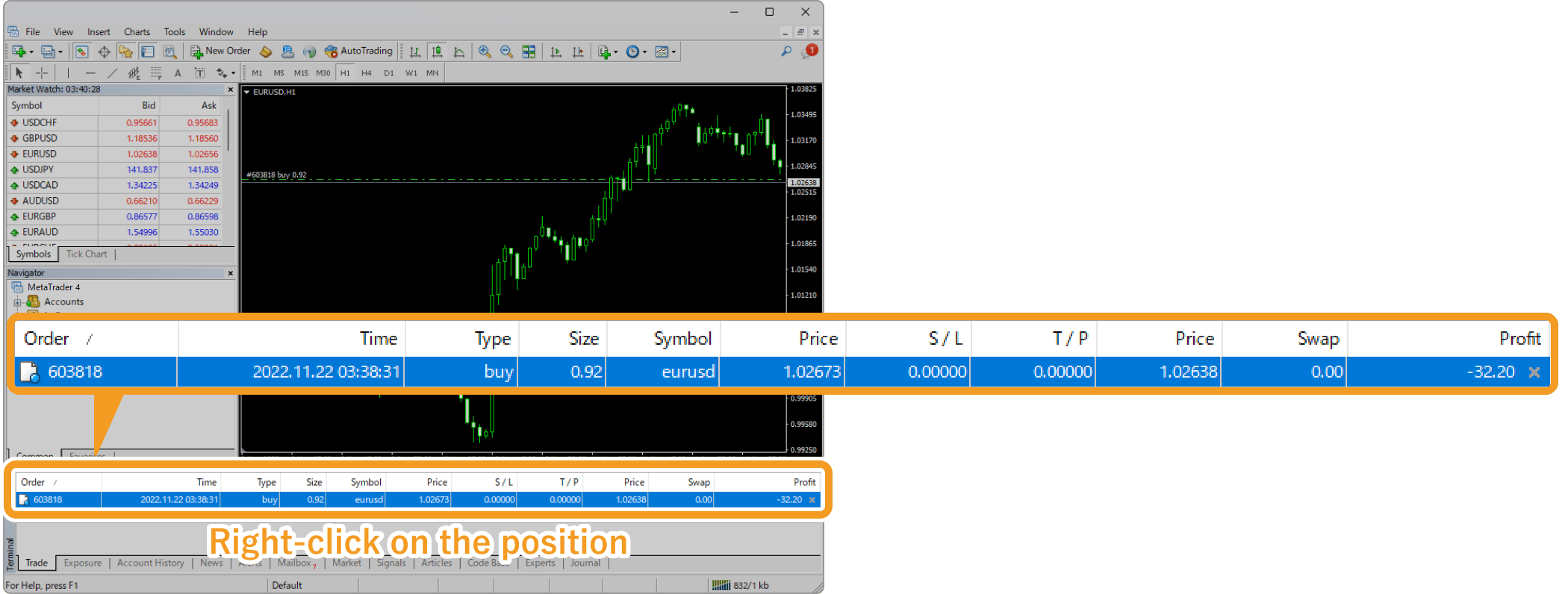
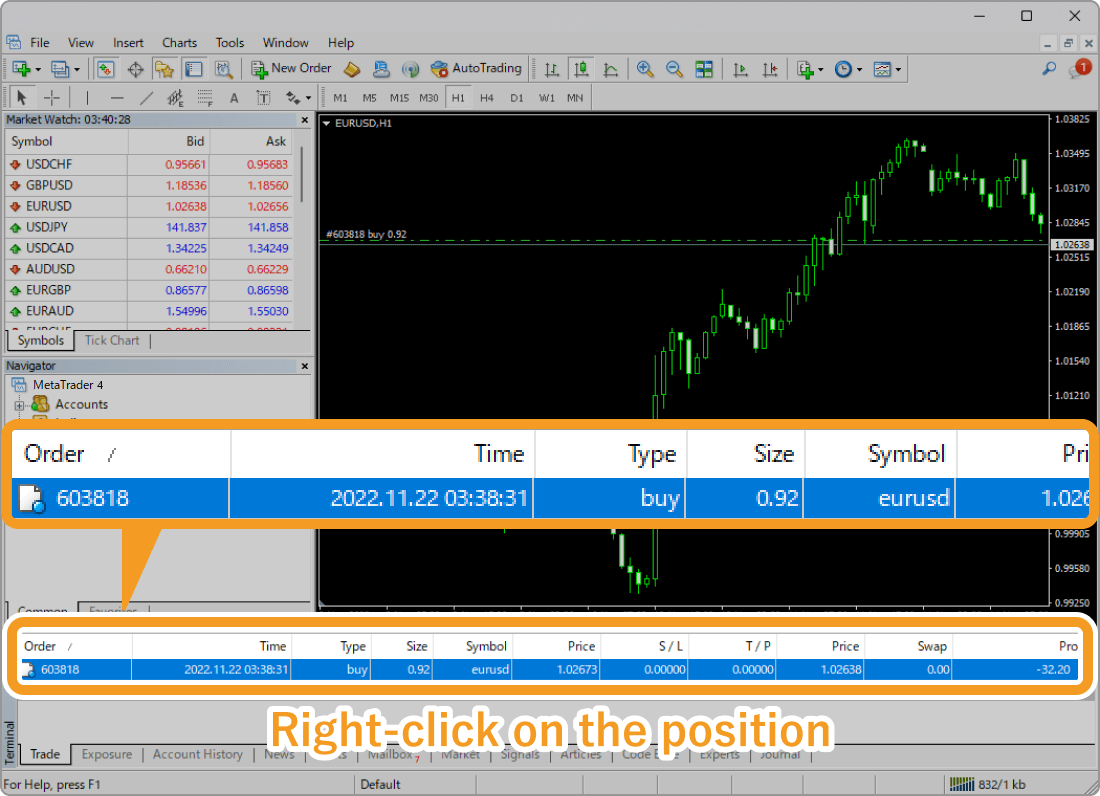
In the context menu, move the pointer to "Trailing Stop" to select the trailing stop level. You can also specify a value by selecting "Custom" and entering the value in points.
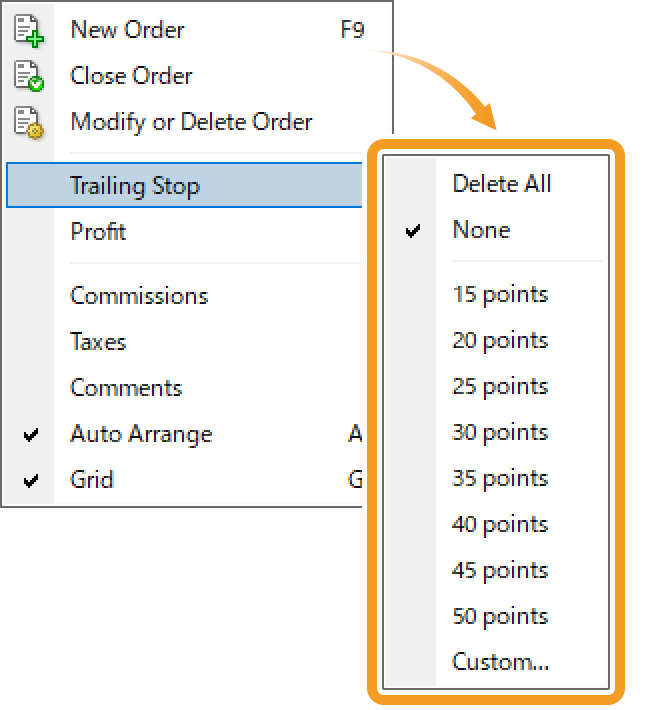
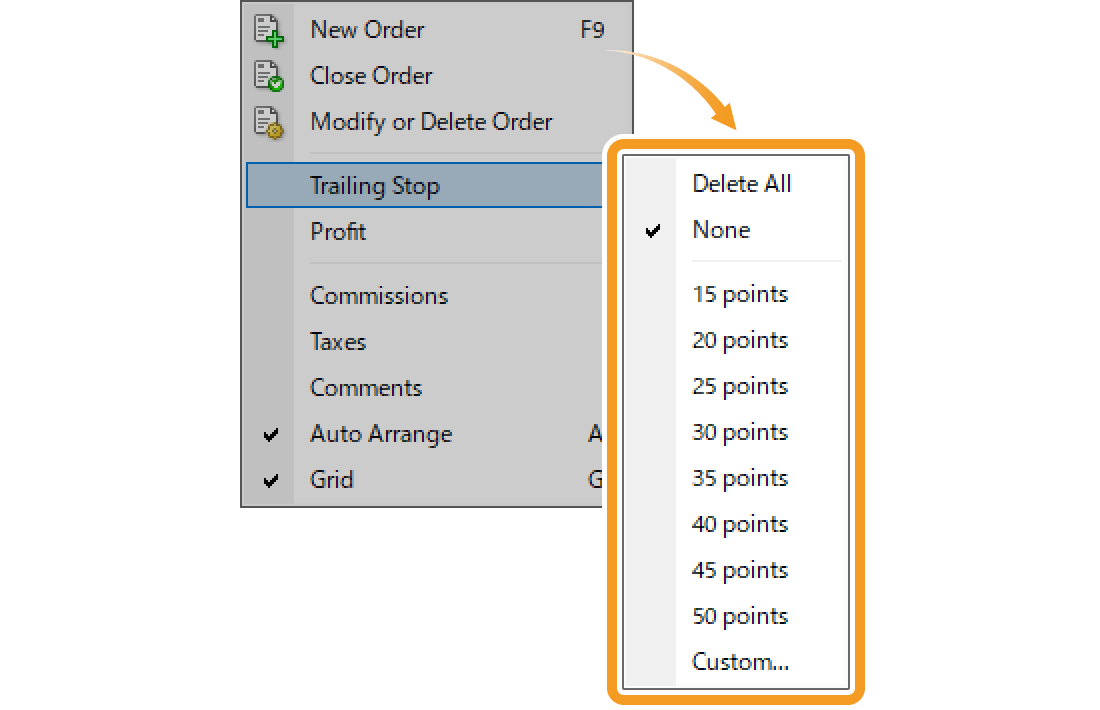
A point, in the context of trailing stop, represents the smallest unit of a rate. For instance, for symbols quoted to three decimal places (e.g., USDJPY), one point equals 0.001.
To set a trailing stop on the chart
Right-click on the dotted line indicating your position on the chart. Select "Trailing Stop" and the trailing stop level as above.
Related article: How to show position on chart
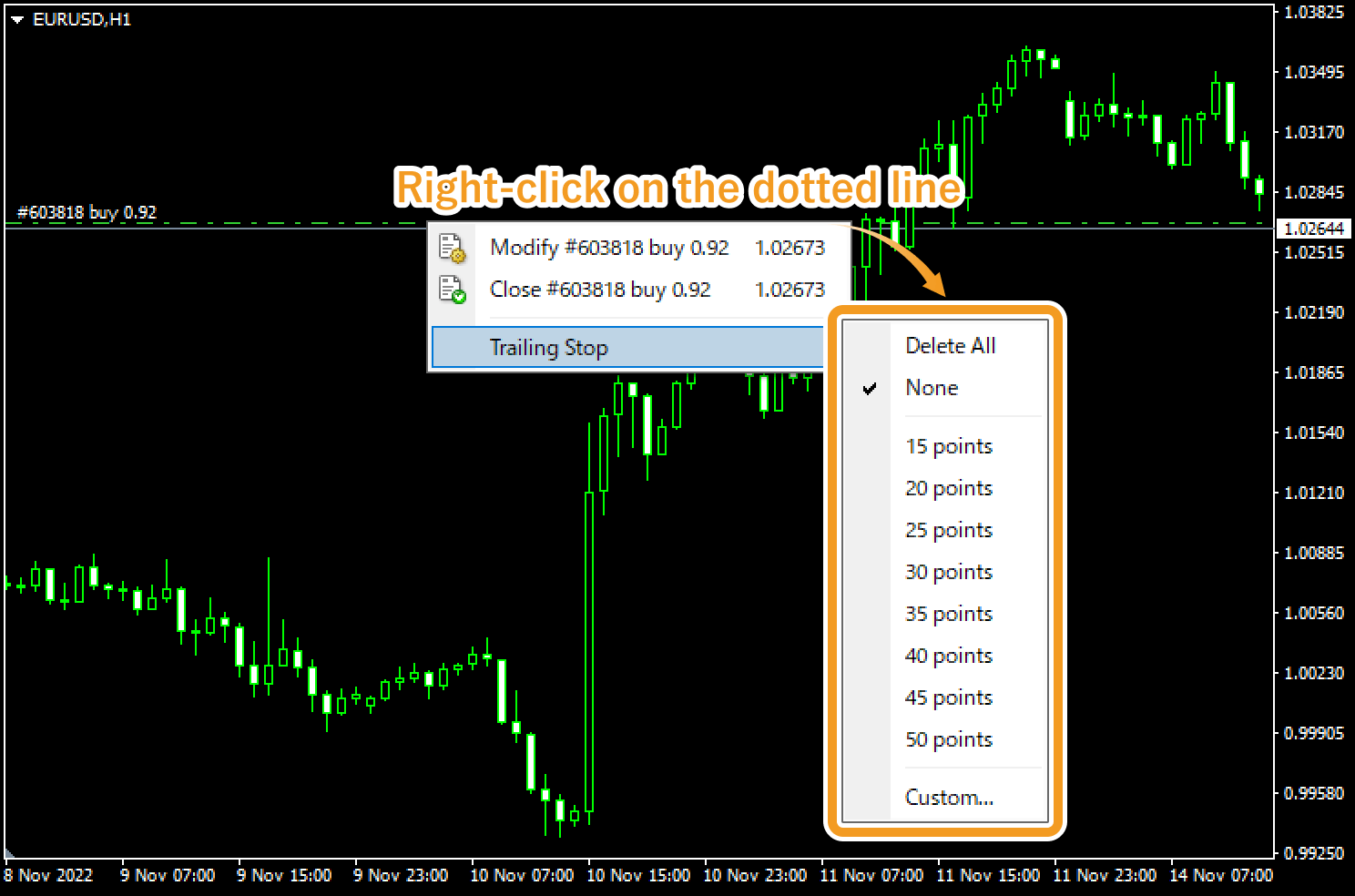
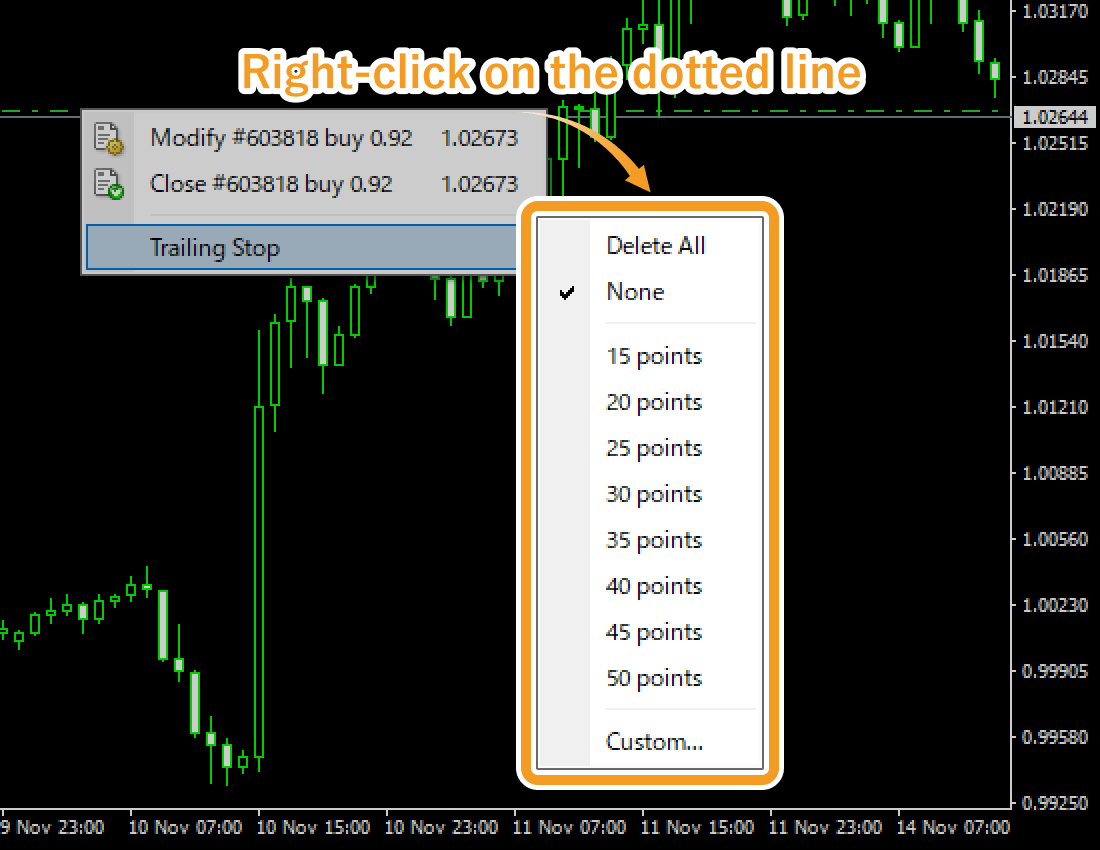
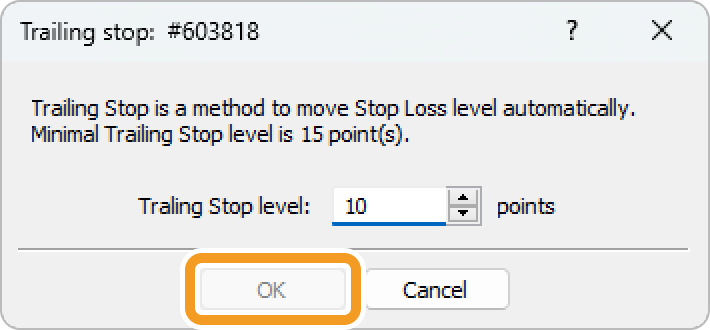

When setting a trailing stop level, you have to specify a value larger than the stop level. Otherwise, the "OK" button will be disabled.
Related article: Check trading conditions
Step 2
Once the trailing stop is set, the "T" mark will appear on the left side of the position details in the Terminal.


Step 3
To disable a trailing stop order, move the pointer over "Trailing Stop" and select "None". To disable all the active trailing stops, select "Delete All".
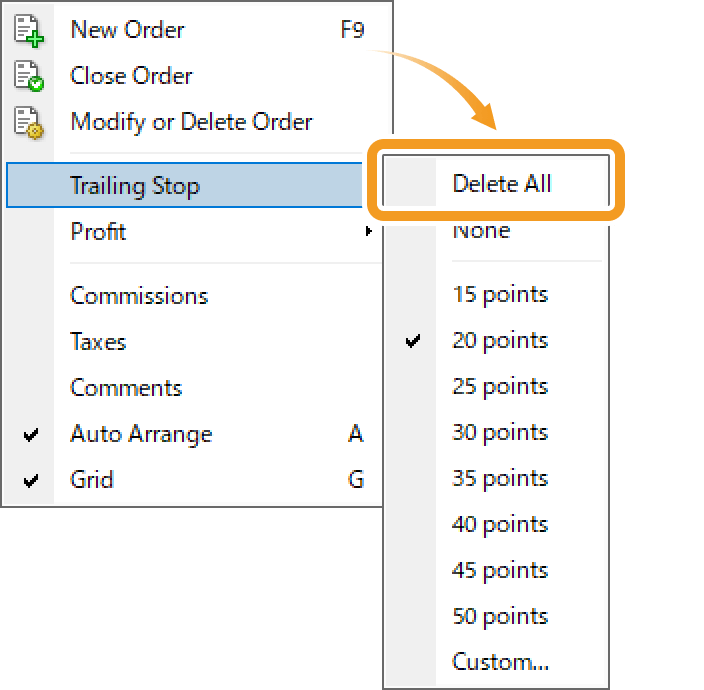
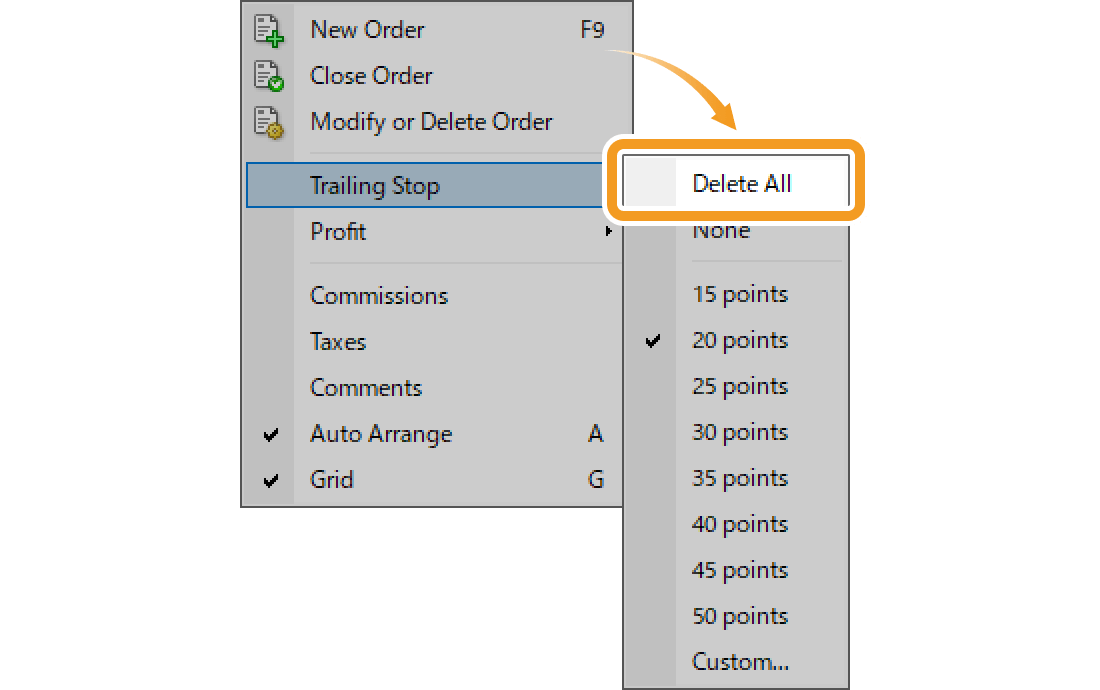
Even if the trailing stop order is disabled as described above, the stop-loss (S/L) value set for the order will remain unchanged. To remove the S/L value, it must be deleted separately.
Related article: Set or change T/P and S/L values
Step 4
Once the trailing stop is disabled, the "T" mark on the left side of the position details will disappear.


Trailing stop is only activated while MT4 is running. If you close your MT4 or switch to the other account, trailing stops will be disabled and the last stop-loss price will remain unchanged.
Step 1
Trailing stop orders are available from the Toolbox or chart.
To set a trailing stop from the Toolbox
Click the "Trade" tab in the Toolbox and right-click on the position you wish to set a trailing stop for.
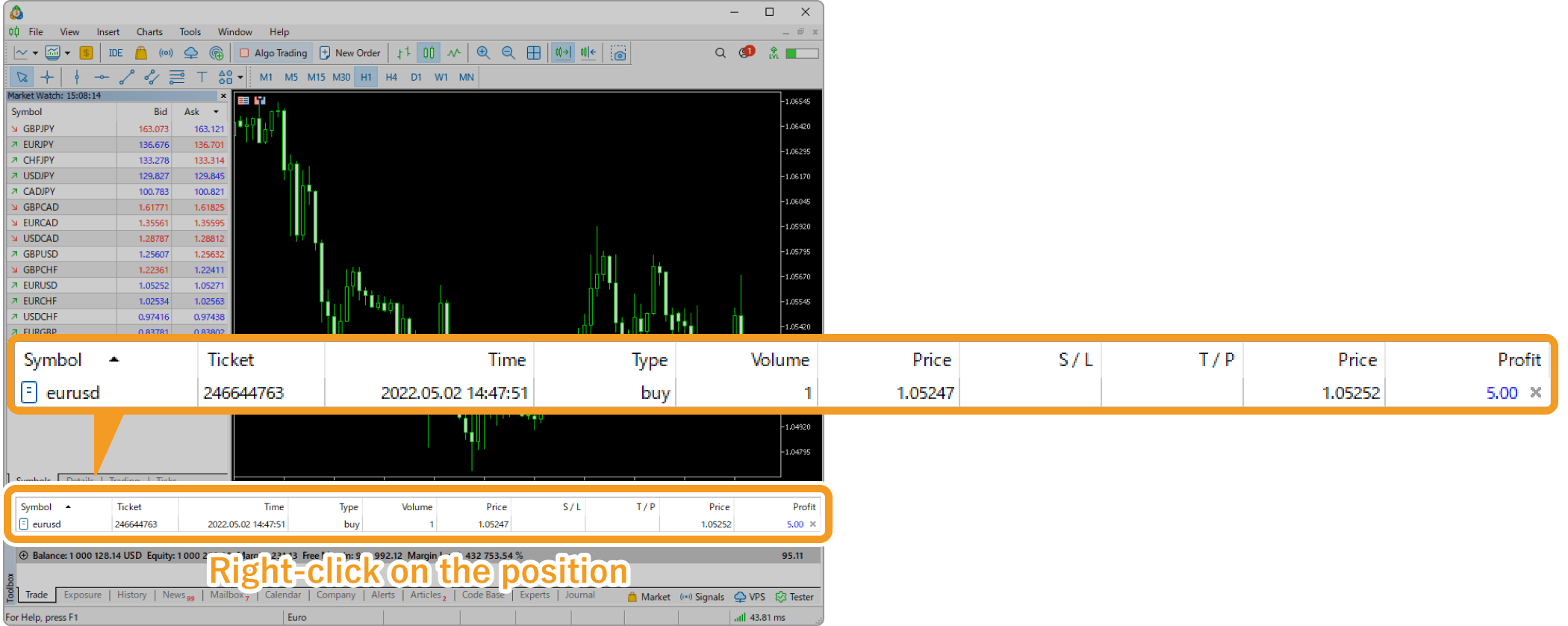
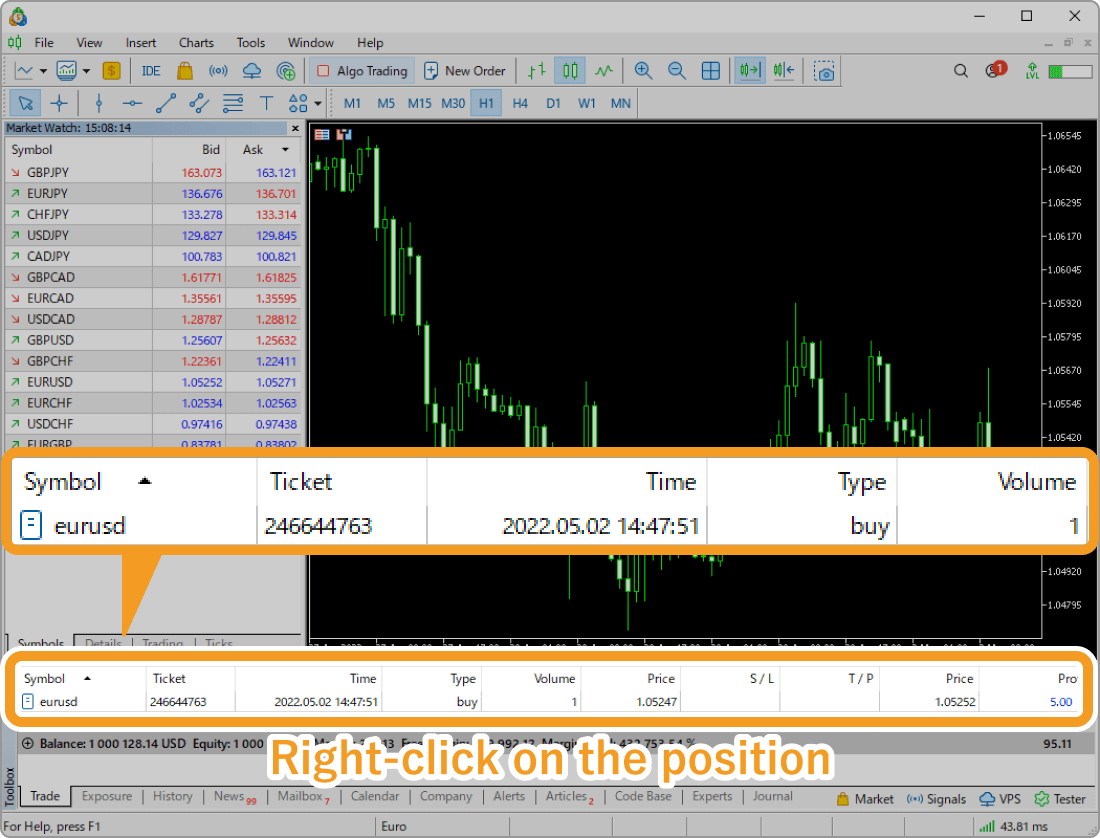
In the context menu, move the pointer to "Trailing Stop" to select the trailing stop level. You can also specify a value by selecting "Custom" and entering the value in points.
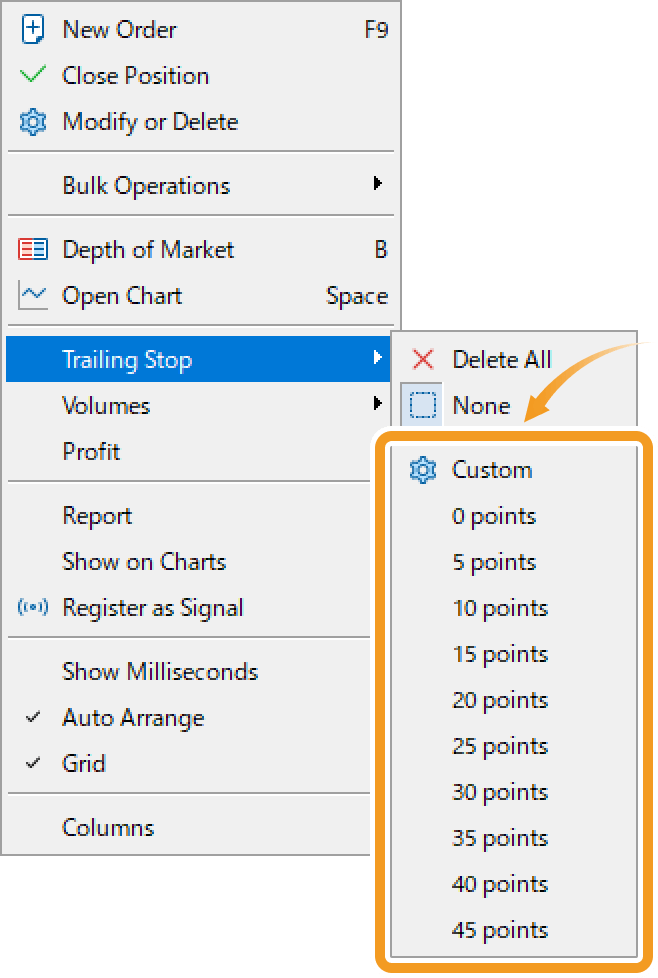
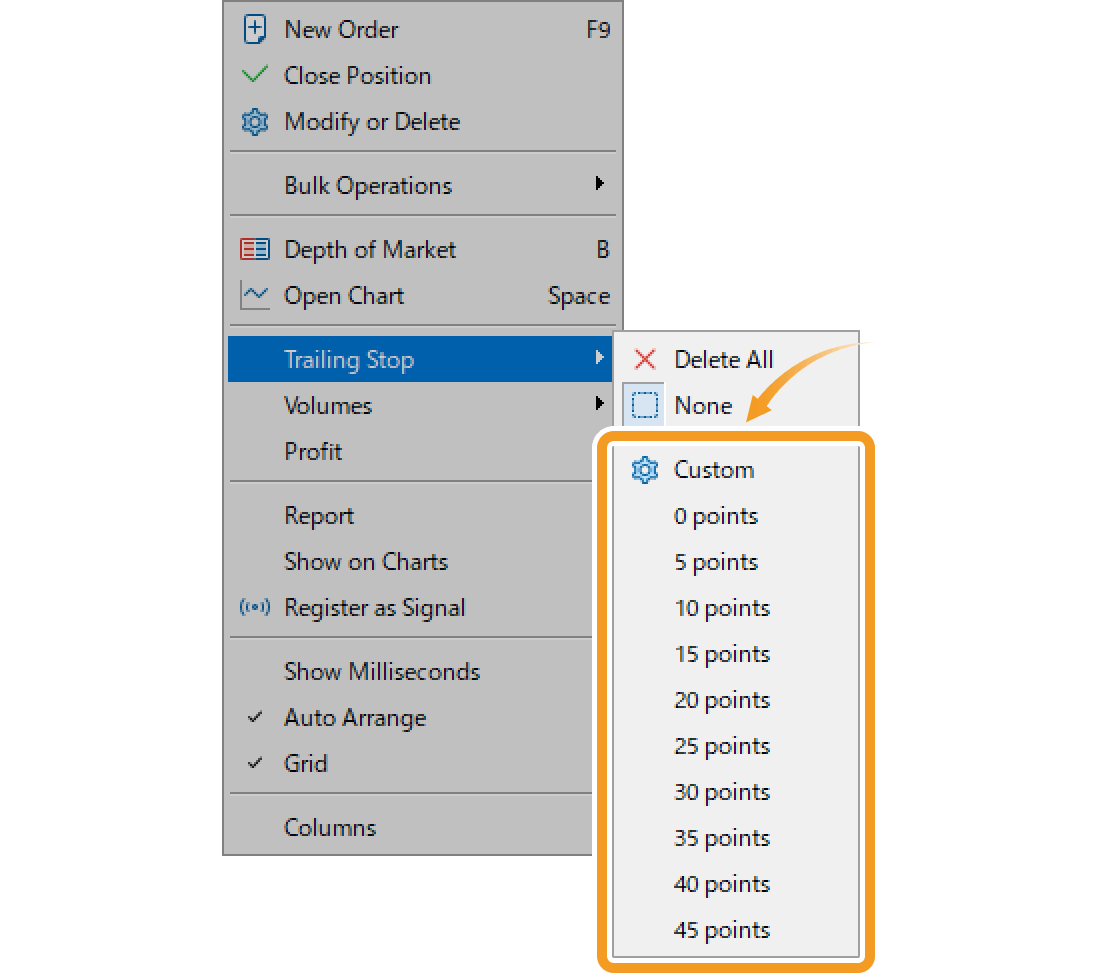
A point, in the context of trailing stop, represents the smallest unit of a rate. For instance, for symbols quoted to three decimal places (e.g., USDJPY), one point equals 0.001.
To set a trailing stop on the chart
Right-click on the dotted line indicating your position on the chart. Select "Trailing Stop" and the trailing stop level as above.
Related article: How to show position on chart
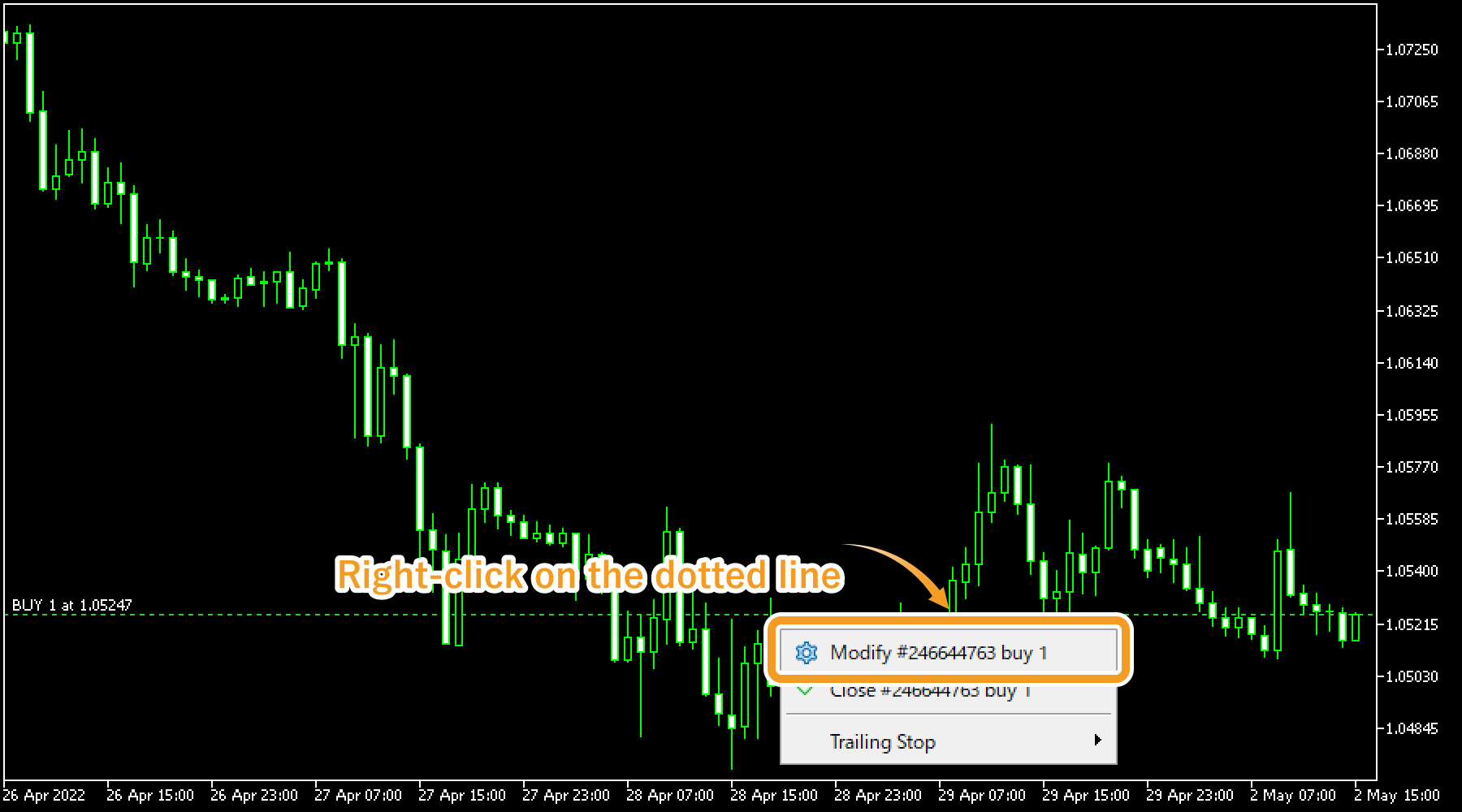
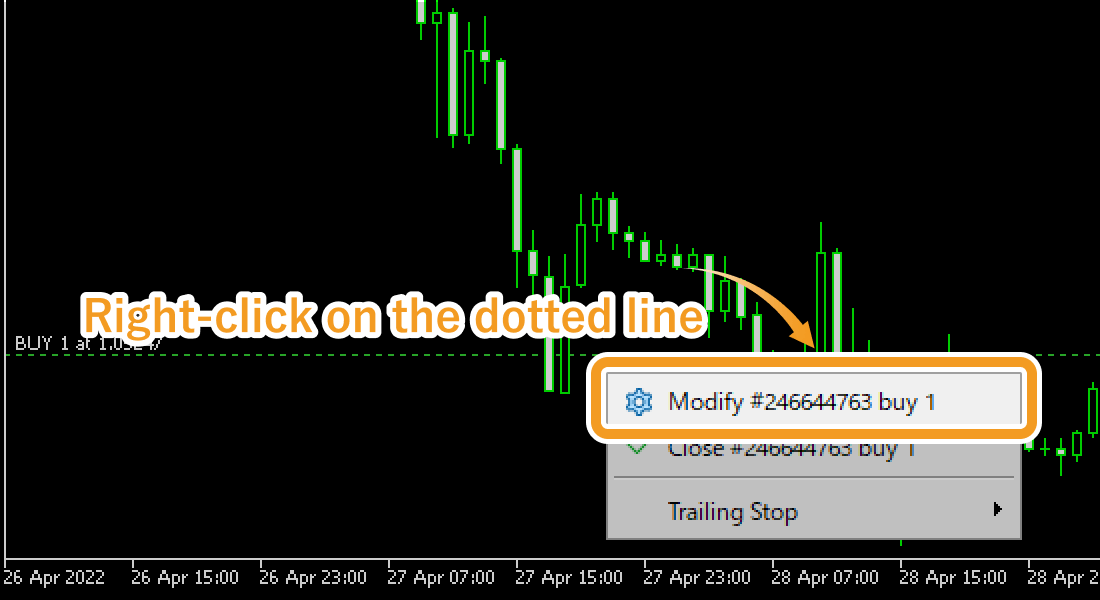
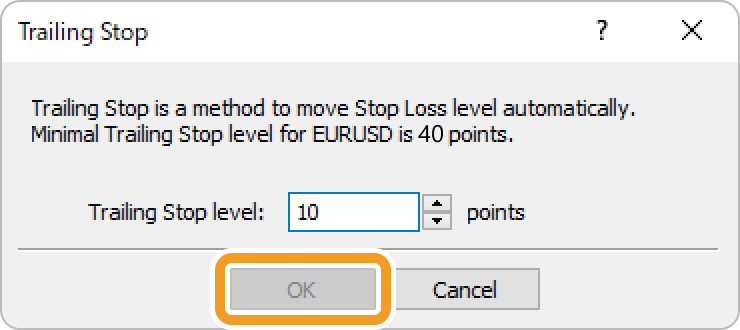

When setting a trailing stop level, you have to specify a value larger than the stop level. Otherwise, the "OK" button will be disabled.
Related article: Check trading conditions
Step 2
Once the trailing stop is set, the "T" mark will appear to the left of the symbol of the position in the Toolbox.


Step 3
To disable a trailing stop order, move the pointer over "Trailing Stop" and select "None". To disable all the active trailing stops, select "Delete All".
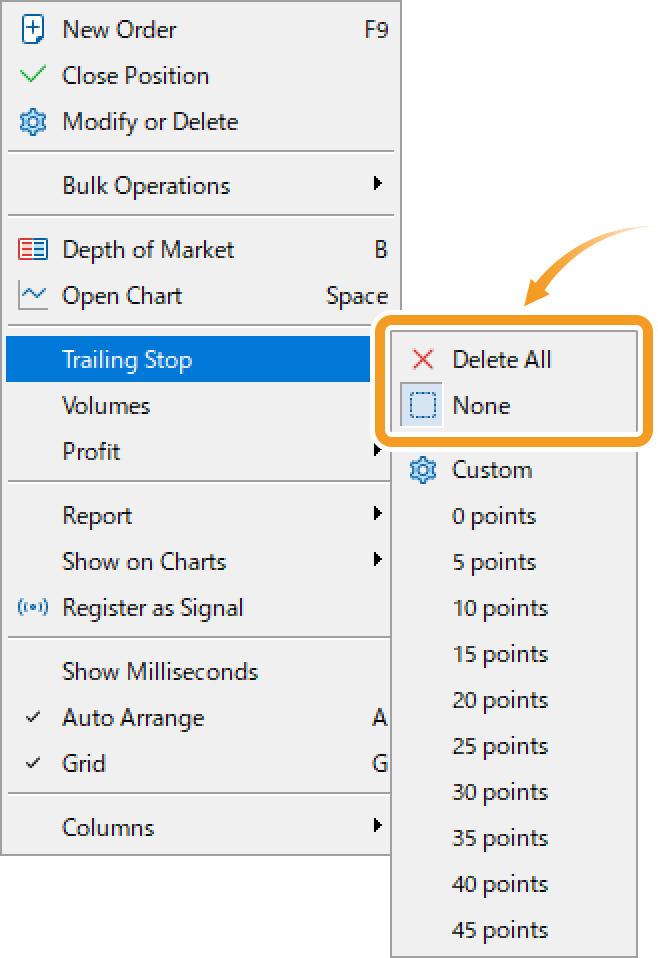

Even if the trailing stop order is disabled as described above, the stop-loss (S/L) value set for the order will remain unchanged. To remove the S/L value, it must be deleted separately.
Related article: Set or change T/P and S/L values
Step 4
Once the trailing stop is disabled, the "T" mark to the left of the symbol of the position will disappear in the Toolbox.


Trailing stop is only activated while MT5 is running. If you close your MT5 or switch to the other account, trailing stops will be disabled and the last stop-loss price will remain unchanged.
Was this article helpful?
0 out of 0 people found this article helpful.
Thank you for your feedback.
FXON uses cookies to enhance the functionality of the website and your experience on it. This website may also use cookies from third parties (advertisers, log analyzers, etc.) for the purpose of tracking your activities. Cookie Policy
